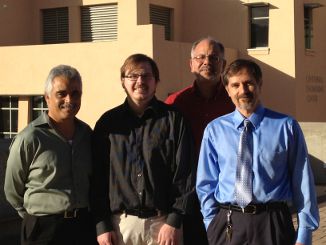- El-Genk, M.S., T. Schriener, Lightweight Heat Pipe Radiator for Nuclear Reactor Power Systems on Lunar Surface. J. Nuclear Technology, 2025. 211(3) 400-428
- Kresl-Hotz, K.R., El-Genk, M.S., Schriener, T.M., Numerical Mesh Refinement for Flow Mixing in Pool Type SFR. Proceedings ANS Student Conference 2025, 2025.
- Kresl-Hotz, K.R., El-Genk, M.S., Schriener, T.M., CFD Analyses of the Flow Mixing and Stratification in Pool Type SFR. Proceedings ANS Student Conference 2025, 2025.
- Schriener T.M., M.S. El-Genk, Armoring Lightweight Foldable Radiator Panel for Lunar Surface Fission Power Systems. J. Nuclear Technology, 2025. 1-25
- Schriener T.M., M.S. El-Genk, Launch Solid Stress Analyses of Ultra-Light Heat Rejection Radiator Module and Panel for Lunar Fission Surface Power. J. British Interplanetary Society, 2025. 78(3) 74-83
- El-Genk, M.S., T.M. Schriener, A.N. Shaheen, Machine-Learning Algorithms for Remote-Control and Autonomous Operation of the Very-Small, Long-Life, Modular (VSLLIM) Microreactor. J. Nuclear Engineering, 2025. 6(4) 54
- El-Genk, M.S., T.M. Schriener, Lightweight Heat Pipe Radiator for Nuclear Reactor Power Systems on Lunar Surface. Nuclear Technology, 2024. 1-29
- Schriener, T.M., M.S. El-Genk, Armored Lightweight Heat Rejection Radiator for Lunar Surface Nuclear Reactor Power Systems. Proceedings ANS 2024 Nuclear and Emerging technologies for Space (NETS 2024), 2024.
- El-Genk, M.S., T. Schriener, Lightweight Heat Pipe Radiator Panel for Lunar Surface Fission Power Systems. Proceedings AIAA ASCEND Conference, 2024.
- El-Genk, M.S., Designs of Space Nuclear Reactor Power Systems for the Avoidance of Single Point Failures, Launch Safety, and a Long Operation Life. Proceedings AIAA ASCEND Conference, 2024.
ISNPS Director Mohamed El-Genk invited to be Panelist at Opening Plenary of 2024 ANS Winter Conference and Expo
12/4/2024
El-Genk invited speaker at the Open Plenary Panel at ANS Winter Meeting, 17-21, 2024
12/9/2024
Masters Graduation - Ahmad Shaheen
Ferris Engineering Center
Room 1120
Mailing Address:
Institute for Space & Nuclear Power Studies
MSC01-1120
1 University of New Mexico
Albuquerque, NM 87131
Phone: 505.277.5442
Fax: 505.277.5433
Online: Contact Form
BREAKING NEWS - Master's Thesis Defense

On Monday, 26 November 2012, Boyce W. Travis (middle front), a Research Assistant with the Institute for Space and Nuclear Power Studies, successfully defended his Master's Thesis in Nuclear Engineering. Thesis committee included Research Assistant Professor Jean-Michel Tournier (front right), Adjunct Associate Professor Sal Rodriguez (front left), and Committee Chair and Thesis Advisor, Regents` Professor Mohamed S. El-Genk.
An Effective Methodology for Thermal- Hydraulics Analysis of a VHTR Core and Fuel Elements
Abstract
The Very High Temperature Reactor (VHTR), a Generation-IV design, is graphite moderated and helium cooled and operates at an exit temperature of up to 1273 K, for generating electricity at a plant thermal efficiency upwards of 48% and the co-generation of process heat for hydrogen production and other industrial uses. This research developed an effective thermal-hydraulics analyses methodology that markedly reduces the numerical meshing requirements and computational time. It couples the helium's 1-D convective flow and heat transfer in the channels to 3-D heat conduction in graphite and fuel compacts of VHTR fuel elements. Besides the helium local bulk temperature, the heat transfer coefficient is calculated using a Nusselt number correlation, developed and validated in this work. In addition to omitting the numerical meshing in the coolant channels, the simplified analysis methodology effectively decreases the total computation time by a factor of ~ 33 - 40 with little effect on the calculated temperatures (< 5 K), compared to a full 3-D thermal-hydraulics analysis. The developed convective heat transfer correlation accounts for the effect of entrance mixing in the coolant channels, where z/D < 25. The correlation compares favorably, to within 12%, with Taylor's (based on high temperature hydrogen heat transfer) and to within 2% of the calculated results for full 3-D analyses of a VHTR single channel module and multiple channels in the fuel elements. The simplified methodology is used to investigate the effects of helium bypass flow in interstitial gaps between fuel elements and of the helium bleed flow in control rod channels on calculated temperatures in the VHTR fuel elements. Thermal-hydraulics analysis of a one-element high and of a full height VHTR 1/6 core are also conducted. Results show that the interstitial bypass flow increases the temperatures near the center of the core fuel elements by 10-15 K, while reducing temperatures along the edges of the elements by ~30 K. Without helium bypass flow, hotspots may occur at the location of burnable poison rods in the fuel elements, depending on the assumed volumetric heat generation rate in the rods. The helium bleed flow through the control rod channels reduces temperatures near them by 2-5 K, and only slightly increases the temperatures within the rest of the core fuel elements. In the VHTR 1/6 core thermal-hydraulics analysis, the helium bypass flow decreases the heat transfer from the core fuel elements to the adjacent radial graphite reflector blocks. Results demonstrate the effectiveness of the developed methodology and its potential use in future thermal-hydraulics design and in the safety analyses of VHTRs.



